AMX DXF-TX-SMD Handleiding
AMX
Niet gecategoriseerd
DXF-TX-SMD
Bekijk gratis de handleiding van AMX DXF-TX-SMD (2 pagina’s), behorend tot de categorie Niet gecategoriseerd. Deze gids werd als nuttig beoordeeld door 88 mensen en kreeg gemiddeld 5.0 sterren uit 44.5 reviews. Heb je een vraag over AMX DXF-TX-SMD of wil je andere gebruikers van dit product iets vragen? Stel een vraag
Pagina 1/2

QUICK START GUIDE
DXLink™ Fiber Transmitters and Receivers
Overview
Applicable units for this guide include the DXF-TX-MMD, DXF-RX-MMD, DXF-TX-SMD,
DXF-RX-SMD, DXF-TX-MMS, DXF-RX-MMS, DXF-TX-SMS, and DXF-RX-SMS.*
All units support InstaGate Pro® and SmartScale® Technology.
* MM = multimode; SM = single mode; D at the end = Duplex; S at the end = Simplex.
Duplex units handle simultaneous-bidirectional or unidirectional data transfer; Simplex
units only handle unidirectional data transfer (multimode and single mode models
support different cable lengths).
The Multi-Format TXs and HDMI RXs transmit HDMI and audio over fiber optic cable
(Duplex models also transmit control data over fiber optic cable). The Multi-Format TXs
also have an input for analog video and an HDMI port on the front for local loop out.
All units can be set up in 1 of 3 ways (follow “Important” note below in all cases):
• Endpoint Mode (Switcher) – connect one or more units to an Enova DGX or Enova
DGX 100 Series Switcher with an integrated Master.
• Endpoint Mode (Standalone) – standalone TX/RX connected directly to each other
with one connected to NetLinx Central Controller via LAN or directly to Controller.
• Extender Mode (Standalone) – connect TX/RX pair directly to each other.
The Hardware Reference Manual – DXLink Fiber Transmitters and Receivers contains
complete documentation (including full specifications and supported input and output
resolutions); see the product page at www.amx.com .
System Setup
IMPORTANT: For standalone pairs and for input/output boards with corresponding
TX/RX units, mix-or-match is allowed for Duplex and Simplex hardware (both types of
boards are also allowed in same enclosure). DXLink Fiber models must match: multimode
to multimode and single mode to single mode. If connecting Duplex and Simplex
products, see the “Hardware Reference Manual” for important information.
The TX and the RX work with a switcher that supports DXLink Fiber Technology for
transmission of HDMI (or with a Central Controller) or as a standalone pair. The TX
receives an HDMI signal (or analog video) and embedded audio from the source. Both
the video and embedded audio are transported over fiber optic cable to a DXLink Fiber
Input Board (or connector). The signal is routed via the DXLink Fiber Output Board (or
connector) to an RX. On TXs, stereo audio or digital audio connections are provided as
supplemental audio inputs. The RXs provide a stereo audio output. The TXs also have
an HDMI local out on the front. All Duplex TXs and RXs support USB, IR, RS-232 (for
serial data transfer) Ethernet. Simplex units only support Unidirectional Mode.
IMPORTANT: FIG. 6 shows duplex LC f iber cable; when using single LC f iber cables, be
sure to verify that the individual fiber from the transceiver’s TX label on one end of the
run are connected to the transceiver’s RX label on the other end and vice versa.
Mounting Options (Rack Trays and Mounting Brackets)
For details on the four versatile mounting kit options for V Style units (rack tray, rack
tray with fill plates, surface mount, and pole mount), see www.amx.com .
IMPORTANT: When mounting under a surface, the units should be mounted upright and
lowered in the mounting bracket slots to provide an airflow gap between the surface and
the vent holes. If not using V Style brackets, be sure to leave a gap between the top of the
unit and the surface for heat to escape.
Fiber Optic Transceivers
The DXLink Fiber Transmitters and Receivers use SFP+ fiber optic transceivers. Fiber
optic transceivers are self-contained modules that send and receive optical signals over
fiber cable. DXLink SFP+ fiber optic transceivers are either multimode or single mode
and must be wired with the corresponding cable type. Both multimode and single mode
transceivers support bidirectional and unidirectional communication.
WARNING: DXLink Fiber units use laser transceivers, which are Class 1 Eye Safe per
IEC 60825-1/CDRH requirements. While the Class 1 category indicates that the
invisible laser used is safe, we recommend avoiding direct eye exposure when using
any optical f iber products (see OSHA directive referenced in the “Hardware
Reference Manual”).
The following information applies to LEDs above fiber optic transceiver on Duplex units.
DIP Switch Toggles – Default OFF (for Auto-setup, see next page)
Before installing the units, find the scenario you are using in the applicable table below
and set the DIP switch toggles accordingly. Toggle #4 can be used for placing Duplex
units in Unidirectional Mode (for information, see the Hardware Reference Manual).
* Connection requires Duplex hardware with both fibers connected and in Bidirectional Mode (will not
work in Unidirectional Mode).
** Connect the ICS LAN port on one of the DXLink Fiber units to a network device (e.g., laptop).
*** Connect the ICS LAN 10/100 port on one of the DXLink Fiber units to the network device
(e.g., laptop) and connect the other unit to the network (the unit with Toggle #1 enabled).
^ With both units connected to boards in an Enova DGX Switcher (provides integrated NetLinx
control), connect the ICS LAN 10/100 port on one of the DXLink Fiber units to the network device
(e.g., laptop, IP controlled projector, AMX ICSLan EXB Device).
IMPORTANT: When connecting a TX or an RX in a standalone pair setup to a Master (or
Virtual Master) for upgrade purposes, Toggles #1 and #3 must be ON . Toggle #2 is only
required on each unit if serial and/or IR control is required from the Master.
^^ Does not apply to DXLink Fiber, Simplex units: Toggle #4 can be set to ON or OFF.
ICS LAN 10/100 Port
The ICS LAN 10/100 port uses twisted pair cable. FIG. 5 shows the LEDs for this port.
Attaching Signal, Transport, and Control Cables
Important Cabling Requirements and Considerations:
• Fiber optic cable with LC termination for snap coupling with SFP+ transceivers
• LC Duplex conforming to ANSI TIA-EIA 604-10 (FOCIS 10A)
• DXLink Fiber multimode transceivers use OM3 50/125 μm multimode fiber optic
cable type over distances of up to 984 feet (300 m)^^^
• DXLink Fiber single mode transceivers use 9/125 μm single mode f iber optic cable
type over distances of up to 6.21 miles (10 km)^^^
• Do not create a network (Ethernet) loop. A network loop is created when the
enclosure and one or more of its DXLink Fiber units connect to a common LAN.
^^^ Cable quality is a determining factor for the maximum length of cable runs.
FIG. 1 DXLINK FIBER TX AND RX ENDPOINTS WITH COMPATIBLE DXLINK FIBER EQUIPMENT
FIG. 2 FIBER OPTIC TRANSCEIVER MARKED BLACK (MULTIMODE) OR BLUE (SINGLE MODE)
AC
DC
FLT
AC
DC
FLT
DXLink Fiber
DXLink Fiber RX
Enova DGX Switcher
Input Board DXLink Fiber
Output Board
DXLink Fiber TX
Fiber optic cable
Destination
device
Source device
Latch and/or label color
Dust plug
SFP+ = enhanced small form-factor
pluggable fiber optic transceiver rated
at 10 Gbps transmission data rate.
FIG. 3 FIBER OPTIC TRANSCEIVER LEDS ON DUPLEX UNIT (SIMPLEX LEDS - SEE MANUAL)
FIG. 4 DIP SWITCH TOGGLES ENABLE/DISABLE SPECIAL FUNCTIONALITY
COMMON SCENARIOS - BIDIRECTIONAL, TOGGLE SETTINGS (#4 MUST BE OFF)
Standalone Setup (TX/RX Pair Direct Connection)* #1 #2 #3
AV signals only (plus serial/IR passthrough) OFF OFF OFF
AV with Ethernet passthrough to a network device** (plus serial/IR
passthrough)
ON OFF OFF
AV with NetLinx control of TX/RX unit and serial/IR ports, plus Ethernet
passthrough to a network device***
ON ON ON
TX/RX Connected to Enova DGX / DGX 100 Series (Switcher Setup) #1 #2 #3
AV signals only OFF OFF OFF
AV with Ethernet passthrough to a network device** ON OFF OFF
AV with NetLinx control of TX/RX unit and serial/IR ports OFF OFF ON
AV with NetLinx control of TX/RX unit and serial/IR ports, plus Ethernet
passthrough to a network device^
ON OFF ON
COMMON SCENARIOS - UNIDIRECTIONAL, TOGGLE SETTINGS (#4 MUST BE ON^^)
Standalone Setup (TX/RX Pair Direct Connection) #1 #2 #3
AV signals only (plus serial/IR passthrough) OFF OFF OFF
AV with NetLinx control of TX/RX unit and serial/IR ports ON ON ON
TX/RX Connected to Enova DGX / DGX 100 Series (Switcher Setup) #1 #2 #3
AV signals only OFF OFF OFF
AV with NetLinx control of TX/RX unit and serial/IR ports ON OFF OFF
FIG. 5 ICS LAN 10/100 (RJ-45) PORT
Video Status LED (left)
Link Status LED (right)
Simplex units - attach fiber
cable on side of transceiver
with illuminated LED.
Off - No video is present
On (solid) - HDCP video is present
Fast blink (mostly On) - unencrypted video is present
Slow blink (mostly Off) - free-run video is present
On - Link status is active
Off - Link status is not active
DIP switch
Transmitter
Receiver
Yellow LED (right)
On - Speed status is 100 Mbps
Off - Speed status is 10 Mbps
On - Link status is active
Off - Link status is not active
Green LED (left)

© 2015 Harman. All rights reserved. SmartScale, NetLinx, Enova, AMX, AV FOR AN IT WORLD, and HARMAN, and their respective logos are
registered trademarks of HARMAN. Oracle, Java and any other company or brand name referenced may be trademarks/registered trademarks of
their respective companies.
AMX does not assume responsibility for errors or omissions. AMX also reserves the right to alter specifications without prior notice at any time.
The AMX Warranty and Return Policy and related documents can be viewed/downloaded at www.amx.com.
3000 RESEARCH DRIVE, RICHARDSON, TX 75082 AMX.com | 800.222.0193 | 469.624.8000 | +1.469.624.7400 | fax 469.624.7153
AMX (UK) LTD, AMX by HARMAN - Unit C, Auster Road, Clifton Moor, York, YO30 4GD United Kingdom • +44 1904-343-100 • www.amx.com/eu/
93-1010-360 REV: D
Last Revised: 12/15/2015
IMPORTANT: We recommend DXLink Fiber units be installed by a technician with
knowledge of networks and experience with NetLinx Studio and Telnet. NetLinx experience
should include changing device addresses, binding devices, updating firmware, etc.
WARNING: DXLink Fiber units use laser transceivers, which are Class 1 Eye Safe per
IEC 60825-1/CDRH requirements. While the Class 1 category indicates that the
invisible laser used is safe, we recommend avoiding direct eye exposure when using
any optical f iber products (see OSHA directive referenced in the manual).
To attach signal, transport, and control cables to a Transmitter:
1. Set DIP switch toggles if necessary (for settings, see table on previous page).
2. Video In – Attach HD-15 cable from source device to the Video In connector.
3. HDMI In – Attach HDMI cable from source to HDMI In connector (a DVI cable can
be used via a cable adapter; however, advanced audio support from HDMI will not
be available.).
4. Clean end face on the fiber cable following manufacturer’s recommendations.
5. Fiber optic transceiver – Remove the dust plug (save for further use) and attach a
fiber optic cable* to the fiber optic transceiver (for transport to switcher) –
always grasp fiber connector housing to plug (or unplug) a fiber optic cable
(depending on housing, a click may be heard; if not, lightly tug to be sure
connection is tight).
6. Digital Audio In jack (optional) – Insert the S/PDIF plug on the digital audio cable
from the source into the jack.
7. Stereo Audio In jack (optional) – Insert analog audio cable from source.
8. ICS LAN10/100 port (optional) – Attach twisted pair cable from this port to LAN.
9. Local Out port (optional) – On TX front, attach HDMI cable from local monitor.
* See “Important Cabling Requirements and Considerations” on previous page.
To attach signal, transport, and control cables to the Receiver:
1. Set DIP switch toggles if necessary (for settings, see previous page).
2. Clean end face on the fiber cable following manufacturer’s recommendations.
3. Fiber optic transceiver - Remove dust plug (save for further use) and attach fiber
optic cable** to fiber optic transceiver (for transport from switcher) – always
grasp fiber connector housing to plug (or unplug) fiber optic cable (depending on
housing, a click may be heard; if not, lightly tug to be sure connection is tight).
4. HDMI Out – Attach HDMI cable from this port to the destination device.
5. ICS LAN10/100 port (optional) – Attach twisted pair cable from this port to LAN.
6. Stereo Audio Out jack (optional) – Connect an analog audio cable from this port
to the destination.
** See “Important Cabling Requirements and Considerations” on previous page.
Applying Power
This table shows LED states on initial power up. Follow directions for applying power at
top of next column. If LEDs do not show normal status, check connections.
A desktop power supply (ENERGY STAR® qualified) is provided with each TX and RX.
CAUTION: The provided desktop power supply must be used to power the DXLink Fiber TX
and RX, and it must not be altered in any way.
To apply power to the Transmitter and/or Receiver:
1. Plug the cord from the desktop power supply (provided) into the power jack on
rear of the unit (2.1 mm DC jack for 12 V local power).
2. Plug the desktop power supply into an AC external power source. The Power LED
on the front of the unit illuminates green, indicating a ready state.
DXLink Auto-setup with Enova DGX 100 Series Switchers
Auto-setup is default for using DXLink units with Enova DGX 100 Series Switchers.
When the following conditions are met, units automatically go into Auto-setup Mode
and can communicate through the ICS LAN port with the integrated Master via Telnet:
• Endpoints must be set to DHCP Mode (default) and use the NDP Master
connection mode (default).
• Endpoints must not be bound to a Master.
IMPORTANT: On the switcher, the ICS LAN port acts as a DHCP server (private LAN) and
the LAN 100/1000 port acts as a DHCP client (public LAN) with each port on a separate
network. In order to avoid a Network Loop, do not connect any device on a public network
to any branch on a private network.
IP Addressing Modes
DHCP Mode (enabled when Toggle #3 is flipped ON)
In DHCP Mode, the unit attempts to get a DHCP lease (consisting of an IP address,
gateway, and other network parameters). If the attempt fails, the unit configures itself
for a link-local address, but periodically re-tries DHCP and re-assigns the IP to a valid
DHCP grant if successful. At any time, if the unit determines that its IP address has
changed, the unit will disconnect and reconnect to the Master.
Static IP Mode (set with ID button or Telnet command)
With Toggle #3 set to ON, press ID for 10 seconds to assign address of 192.168.1.2 or
use a Telnet command to set unit to Static IP (see the Hardware Reference Manual).
Enova DGX and DXLink Fiber IP Setup (for systems without auto-setup)
The following procedure is intended to outline the steps necessary for network setup of
DXLink Fiber TX and/or RX with an Enova DGX switcher. These steps require familiarity
with NetLinx Studio. If unfamiliar with NetLinx Studio, complete instructions are
included in the units’ Hardware Reference Manual at www.amx.com .
To setup DXLink Fiber units with an Enova DGX switcher:
1. Set DIP switch Toggles on DXLink Fiber units (#2 and #4 must be set to OFF).
2. Apply power to the DXLink Fiber units.
3. Connect DXLink Fiber units to the DXLink Fiber Boards on the Enova DGX.
4. Optional – Configure a Static IP address (for each connected unit).
5. Check to be sure DIP switch Toggle #3 is set to ON.
6. Push and hold ID button for 10 seconds. The Static IP sets to 192.168.1.2.
7. Configure the Device ID (for each connected unit).
8. In NetLinx Studio’s Online Tree, open a Telnet session (right-click unit and select
Launch Telnet Window via NetLinx Studio).
9. In the Telnet Window, type SET DEVICE <device number> and press Enter (e.g.,
“SET DEVICE 6001” configures the Device ID to 6001).
10. Connect (bind) the DXLink Fiber units to the Enova DGX.
a. NDP (default) Mode – (1) In NetLinx Studio’s Online Tree, right-click on the
DXLink unit and select Network Bind/Unbind Device; (2) in the Bind/Unbind
Device dialog, select the switcher; (3) click OK.
b. UDP/URL, TCP/URL, or AUTO Mode – (1) In Telnet Window, type SET
CONNECTION; press Enter; (2) follow on-screen directions for desired mode.
RS-232 Serial Data (Optional)
The 232 port label is relative to data flow. Data enters the Transmitter at RX label, is sent
via a fiber cable through the switcher, and leaves the Receiver at TX label. Flow is vice
versa from Receiver to Transmitter. Applies to all DXLink Fiber units – wire RS-232 port
for serial data transfer according to pinout above connectors (TXD-RXD-Ground).
IR Control (Optional)
The IR Receiver (FG-IR03) connects to IR RX port on Transmitter and IR Emitter
(FG10-000-11) connects to IR TX port on Receiver or vice versa, depending on the
installation. The signal is sent via fiber cable between switcher and units. When TX and
RX units are used as a standalone pair, IR control acts as a passthrough.
USB Host & Keyboard/Mouse Ports Provide HID Support (Rear)
If needed, the Host (USB-mini A/B) port on TX units and the Keyboard/Mouse port
(USB-mini A/B) on RX units provide HID support for a keyboard, mouse, and HUB.
Program Port (Front)
This USB mini-B port on the Transmitters supports DGX Configuration Software for
programming a customer VGA EDID (for units connected to an Enova DGX 100 Series
Switcher, use the System Configuration interface; see the switcher’s manual).
ID Button (Front)
The ID button on front can be used to toggle between static and DHCP IP addressing,
assign a device address, reset factory defaults, and restore factory firmware image.
FIG. 6 ATTACH SIGNAL, TRANSPORT, AND CONTROL CABLES (DXLINK FIBER TX SHOWN)
FIG. 7 ATTACH SIGNAL, TRANSPORT AND CONTROL CABLES
INDICATOR LEDS NORMAL POWER UP INDICATES
Power Green Power is applied
Digital Video and Audio Green Video and HDMI embedded
audio are present
TX - Analog Video:
C, Y/C, Y/PB/PR, RGB, RGBHV,
RGBS
Green or Off
(only one of the three
can be green at a time)
Corresponding signal is
present
RX - Scaling: Bypass/Auto/Manual One green, two off Current scaling mode
IR TX / IR RX Red / Yellow IR activity
232 (Serial) TX / 232 (Serial) RX Red / Yellow Serial activity
NetLinx Link/Act Green Active LAN connection to
an AMX Network
NetLinx Status Green LAN activity
CEC Off Not currently supported
USB Yellow Connection established
ICS LAN 10/100 port
Power Video In HDMI In USB port
DXLink Fiber output Stereo Audio In Digital Audio In
Product specificaties
| Merk: | AMX |
| Categorie: | Niet gecategoriseerd |
| Model: | DXF-TX-SMD |
Heb je hulp nodig?
Als je hulp nodig hebt met AMX DXF-TX-SMD stel dan hieronder een vraag en andere gebruikers zullen je antwoorden
Handleiding Niet gecategoriseerd AMX
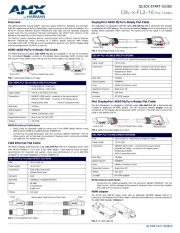
11 Juni 2025
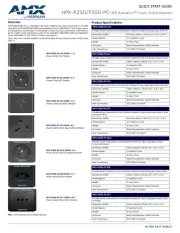
10 Juni 2025
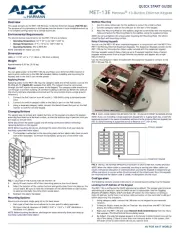
9 Juni 2025
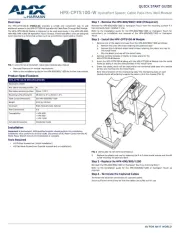
9 Juni 2025
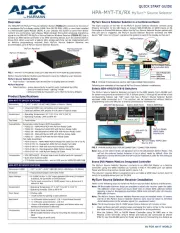
9 Juni 2025
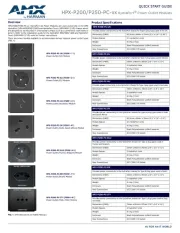
9 Juni 2025
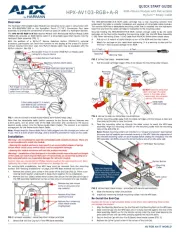
9 Juni 2025
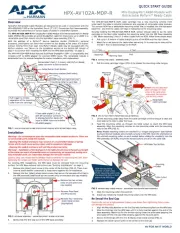
9 Juni 2025

9 Juni 2025

9 Juni 2025
Handleiding Niet gecategoriseerd
- HELGI
- Lepu Medical
- Baninni
- Tenda
- Astera
- Husqvarna
- Novis
- FoxFury
- Blackburn
- AutoParkTime
- Asrock
- Steiner
- Lupilu
- Logilink
- Ibico
Nieuwste handleidingen voor Niet gecategoriseerd
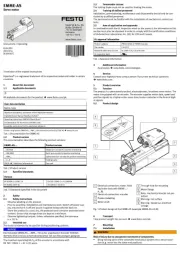
1 Augustus 2025
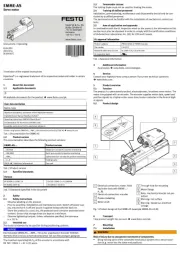
1 Augustus 2025
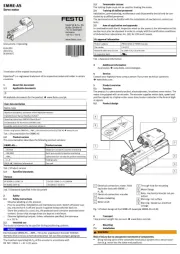
1 Augustus 2025
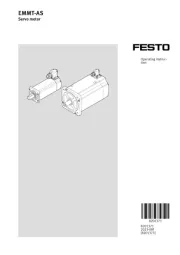
1 Augustus 2025
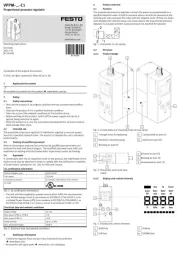
1 Augustus 2025
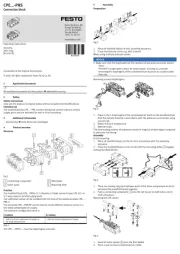
1 Augustus 2025
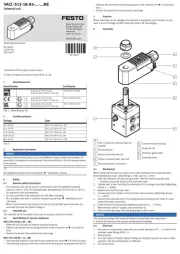
1 Augustus 2025
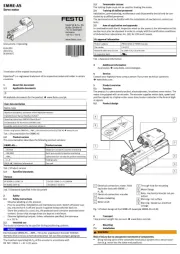
1 Augustus 2025
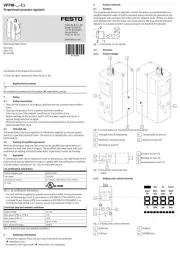
1 Augustus 2025
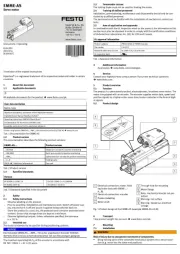
1 Augustus 2025